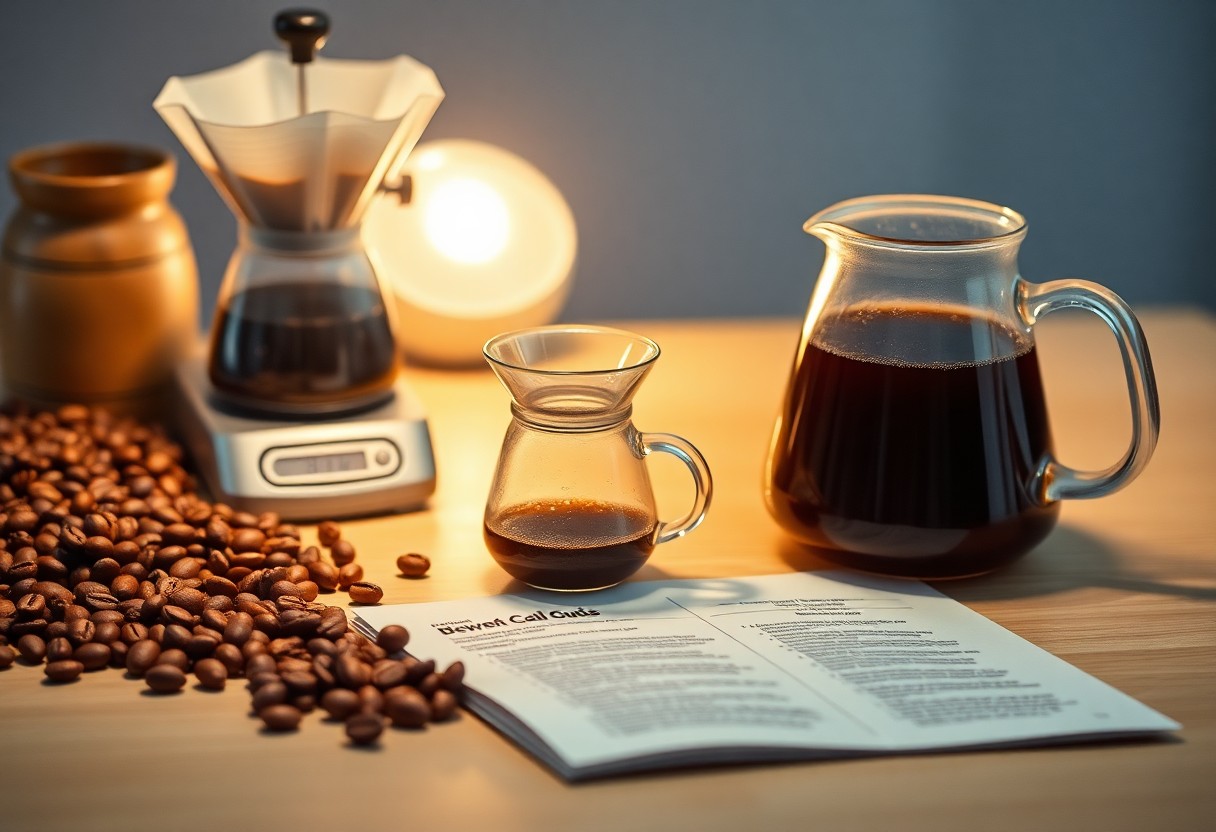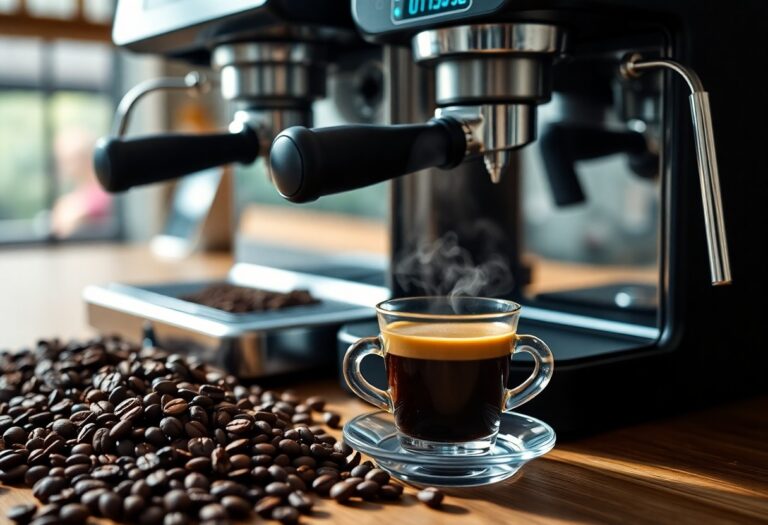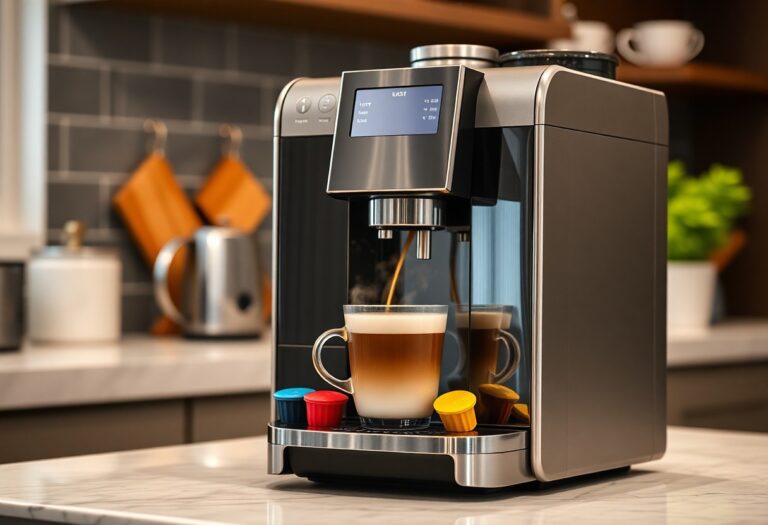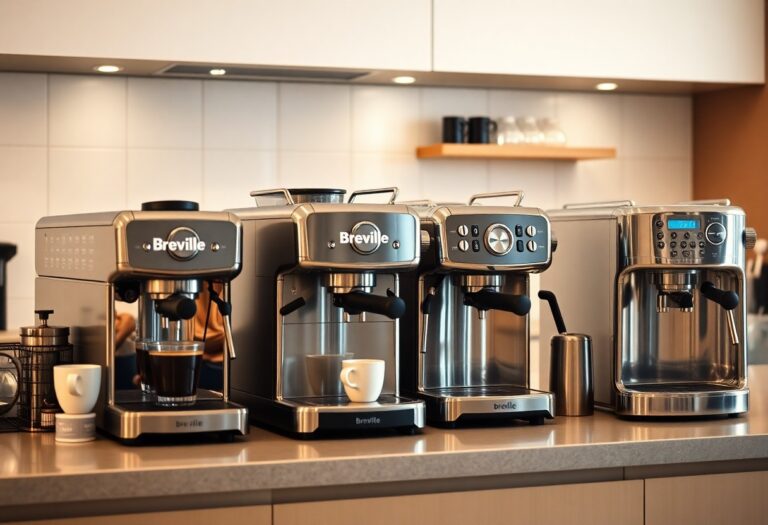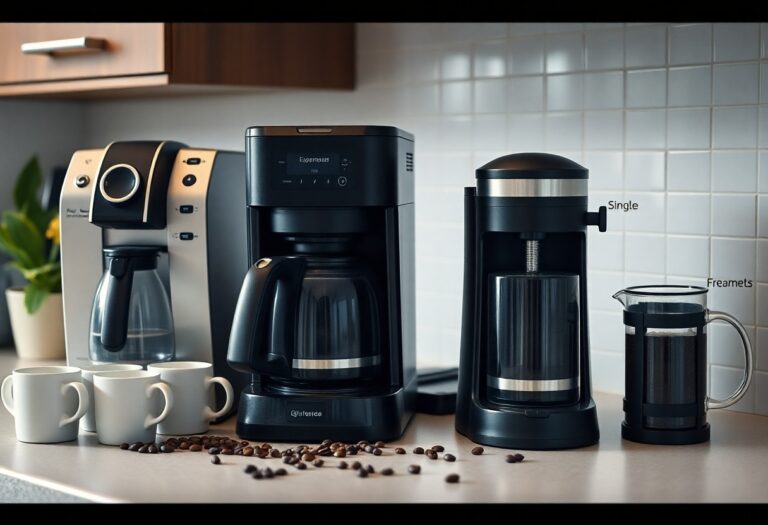What Coffee to Use for a Filter Machine – Filter Brewing Guide
Brewing the perfect cup of coffee starts with choosing the right beans for your filter machine. You’ll want to select coffee that has a medium roast for a balanced flavor, while also considering freshness as key to enhancing your brew. Avoid pre-ground coffee, as it tends to lose flavor over time. Instead, opt for whole beans and grind them just before brewing to unlock their full potential. With the right coffee choice, you can elevate your morning routine and enjoy a delicious cup every time.
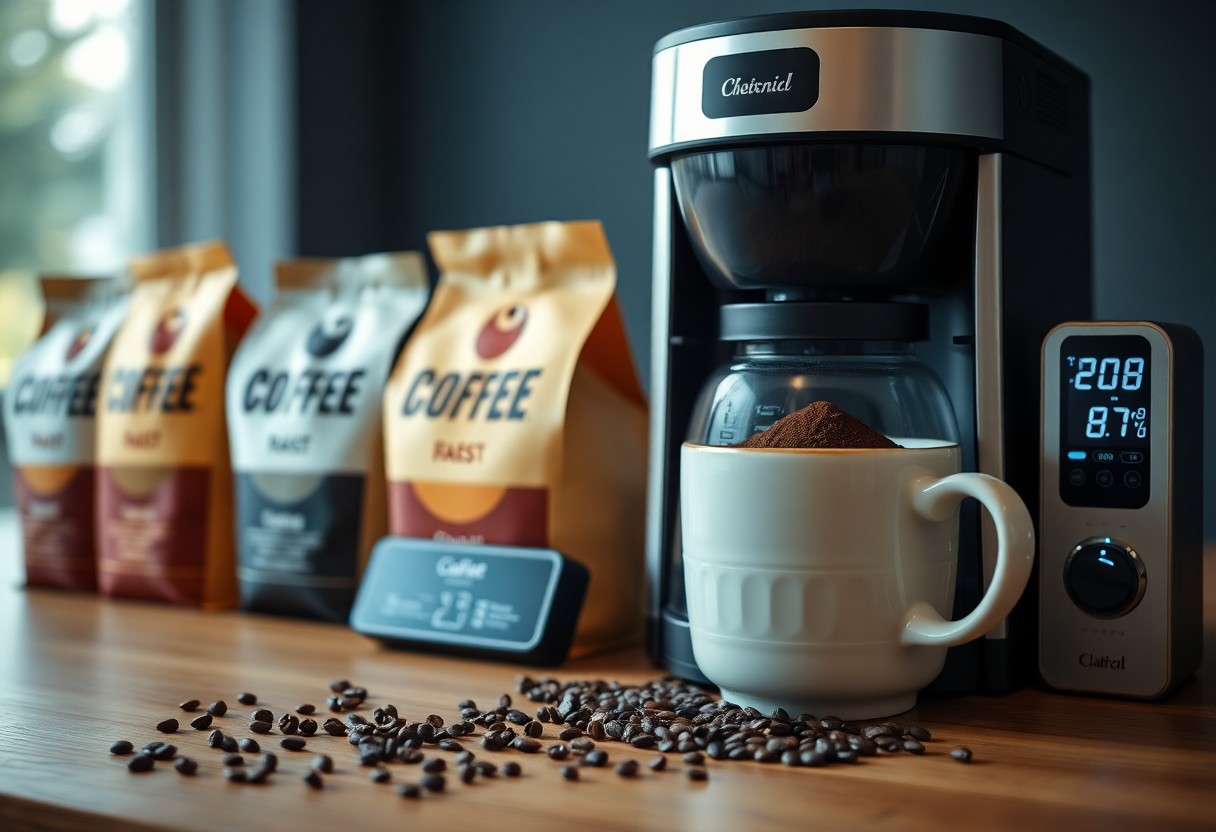
Key Takeaways:
- Opt for medium grind coffee as it provides the best extraction for filter coffee machines.
- Look for fresh, quality coffee beans to enhance flavor; single origin coffees can offer unique profiles.
- Use the appropriate coffee-to-water ratio, typically around 1:15, to achieve the desired strength.
- Consider the roast level; medium to light roasts often yield brighter flavors compared to dark roasts.
- Explore different brewing temperatures; 195°F to 205°F is ideal for optimal extraction and flavor release.
Selecting the Perfect Beans for Filter Brewing
Your choice of coffee beans plays a pivotal role in crafting the ideal cup using a filter machine. Opting for high-quality, single-origin beans often enhances the flavor profile, leading to a better overall experience. Freshness is another key factor—select beans roasted within the last two to four weeks for optimal taste. A variety of coffee bean types exist, and exploring these differences can introduce new flavor nuances to your cup, so be adventurous in your selections.
The Importance of Bean Origin
The origin of your coffee beans significantly affects the flavor and aroma of your brew. Beans sourced from different regions possess unique characteristics, influenced by factors like altitude, soil type, and climate. For instance, beans from Ethiopia often have bright acidity with floral notes, while those from Colombia tend to exhibit a smoother, nutty flavor. By experimenting with beans from various origins, you can discover your personal preferences and elevate your filter brewing experience.
Impact of Roast Level on Flavor Profile
The roast level of your coffee beans directly influences the flavor profile and overall taste experience. Light roasts tend to highlight the beans’ original flavors, giving you vibrant acidity and fruity notes, while medium roasts offer a balanced mix of acidity and sweetness. Dark roasts, in contrast, emphasize a rich, bold taste with less acidity, often featuring chocolatey or smoky undertones. The roast level can make a substantial difference in your cup, so consider what flavor notes you enjoy most when selecting your beans.
A light roast often showcases the unique, complex flavors tied to the beans’ origin, providing delicate notes that can include floral, fruity, or even herbal characteristics. On the other hand, as you progress to medium and dark roasts, these original flavors get overshadowed by the roast itself, giving way to deeper, sometimes bittersweet profiles. If you appreciate a nuanced cup that reflects the terroir of the beans, light or medium roasts may become your go-to. However, if you lean towards a bolder, more robust experience, dark roasts might serve your taste buds best—ultimately, the choice hinges on your preferences and the flavor journey you wish to begin on with your filter brewing.
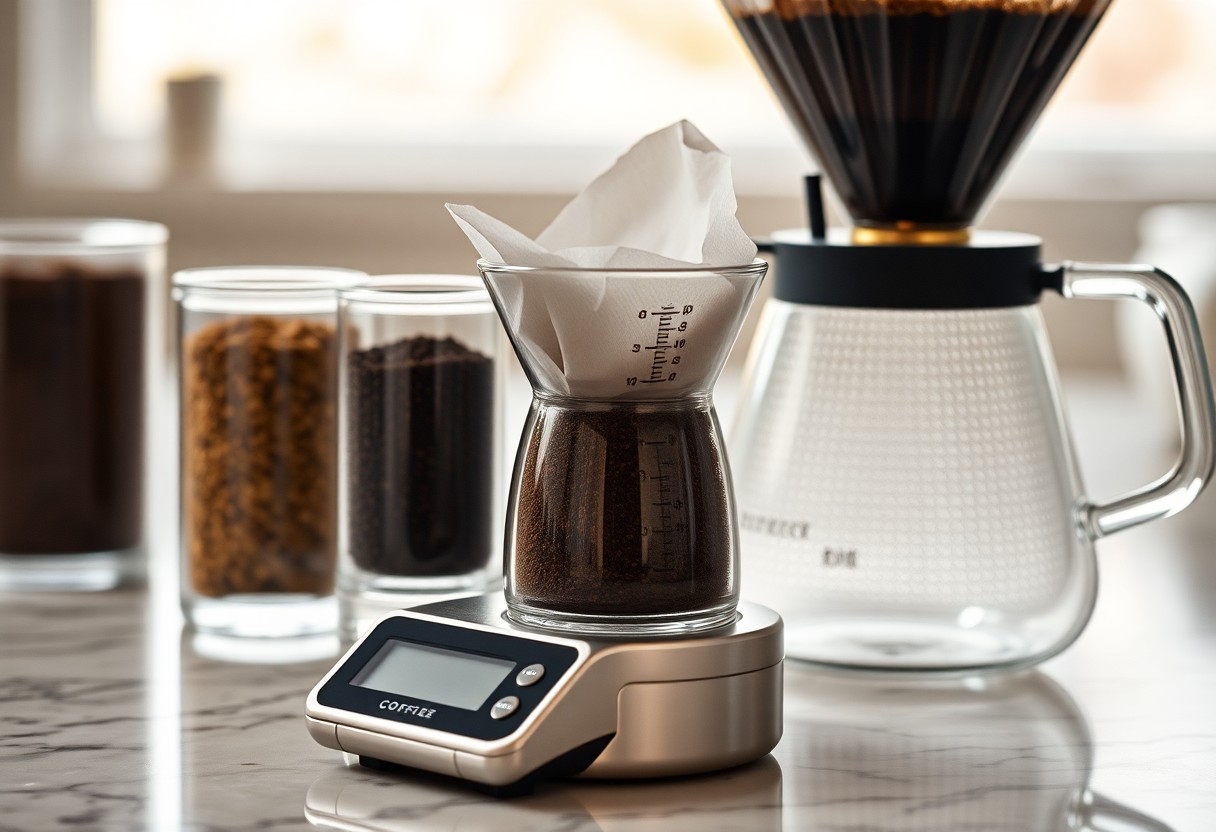
Grind Size Matters: Finding the Right Consistency
The grind size of your coffee can greatly impact the flavor profile and overall quality of your brew. Achieving the right consistency is vital for optimal extraction in filter brewing, allowing the water to evenly saturate the coffee grounds and enhance the extraction of desirable compounds. Think of it as unlocking the full potential of your beans: a medium grind tends to strike the perfect balance, ensuring your cup is both flavorful and aromatic.
The Science Behind Grind Size and Extraction
Grind size directly affects how water interacts with your coffee grounds during brewing. If the grind is too fine, over-extraction may occur, leading to unwanted bitterness. Conversely, a too-coarse grind can result in under-extraction, producing a weak and flavorless cup. Aim for a medium grind, which allows for even extraction by maximizing the surface area while preventing over-brewing.
How to Achieve the Ideal Grind for Filter Coffee
Utilize a burr grinder for consistent results, avoiding blade grinders that can produce uneven grounds. Adjust the setting to a medium grind size, roughly resembling granulated sugar. It’s wise to experiment with slightly different grind sizes based on your specific coffee and taste preferences, as elevation, roast level, and personal palate can influence the ideal outcome. Start with the suggested medium grind and tweak based on your brewing results until you find the perfect match.
Mastering Water Quality: The Unsung Hero of Coffee Flavor
Water quality can significantly impact your coffee’s flavor profile, often overlooked in the brewing process. With coffee being roughly 98% water, the characteristics of the water you’re using can enhance or diminish the nuances of your brew. You might find that filtering your water or using bottled water specifically designed for coffee brewing can reveal complex flavors that tap water may mask.
The Role of Mineral Content in Brewing
Minerals like magnesium and calcium play a key role in the extraction process. These elements not only enhance flavor but also aid in the extraction of oils and aromatic compounds during brewing. For a balanced cup, aim for water with a mineral content that complements the characteristics of your coffee. Consider water that has a total dissolved solids (TDS) level between 75-250 mg/L for the best results.
Temperature and Its Effect on Flavor Extraction
The temperature of your water has a profound influence on the extraction of flavors from coffee grounds. Typically, a brewing temperature ranging from 195°F to 205°F (90°C to 96°C) is ideal. In this range, you can achieve optimal extraction of various soluble compounds, ensuring that the inevitable acidity, sweetness, and body balance harmoniously. Water temperatures outside this range can lead to under-extraction or over-extraction, resulting in a less-than-ideal cup.
Temperature Impact on Extraction
| Temperature Range | Extraction Outcome |
|---|---|
| Below 195°F (90°C) | Under-extraction, resulting in sour or weak flavors. |
| 195°F – 205°F (90°C – 96°C) | Optimal extraction, highlighting the coffee’s richness and balance. |
| Above 205°F (96°C) | Over-extraction, causing bitterness and harsh flavors. |
Finding the right temperature not only assists flavor extraction but also affects the coffee’s aroma and overall experience. For example, brewing at higher temperatures can result in a more pronounced bitterness, overshadowing the underlying flavors you might want to savor. Adjusting your water temperature within the recommended range allows you to tailor your brew to highlight specific taste notes, like fruity or floral undertones, or to enhance sweetness. Exploring these adjustments can truly transform your daily coffee ritual.
Summary of the Brew Temperature Effects
| Effect | Temperature Sensitivity |
|---|---|
| Acidity | Higher temperatures can enhance perceived acidity. |
| Bitterness | Extreme temperatures may lead to overpowering bitterness. |
| Aroma | Higher temps enhance aromatic compounds, amplifying smell. |
Brewing Techniques: Elevating Your Filter Coffee Game
To truly enhance your filter coffee experience, mastering different brewing techniques is vital. Experimenting with variables like temperature, water-to-coffee ratios, and brew times can yield personalized results that suit your palate. For an in-depth guide, check out How to Brew with a Drip Brewer. Fine-tuning these elements ensures your cup of coffee is nothing short of exceptional, allowing for exploration between rich, complex flavors and beautifully balanced brews.
Recommended Brewing Ratios for Optimal Flavor
Finding the right coffee-to-water ratio is vital for optimal flavor extraction. A common starting point is a ratio of 1:15 or 1:16 coffee to water, meaning for every 1 gram of coffee, use between 15 to 16 grams of water. Adjust this based on your taste preference, as some may prefer a stronger brew and others a milder one. Conducting small adjustments can significantly change the outcome, allowing you to align the brew according to your unique flavor preferences.
Timing: When to Start Enjoying Your Brew
Timing plays a pivotal role in enjoying your freshly brewed filter coffee. Generally, the ideal brew time for drip coffee ranges from 4 to 6 minutes, depending on your specific coffee strength and grind size. Taste-testing at different intervals can help you discover your perfect brewing time for that flawless cup.
After brewing, the timing of serving your coffee is vital as well. Aim to enjoy your coffee within 30 minutes of brewing for the best flavor profile. As the coffee sits, oxidation and temperature changes can cause subtle but noticeable shifts in taste. If you need to keep coffee warmer, consider using an insulated carafe. This will help maintain its flavor and aroma, ensuring that every sip remains delightful and satisfying.
Troubleshooting Common Brewing Issues: Enhancing the Experience
Your coffee brewing experience can be greatly affected by various factors, from the grind size to extraction levels. If you find your brew lacking in flavor or too bitter, it’s time for some troubleshooting. Understanding common issues and how to address them can elevate your coffee enjoyment.
Identifying Over-Extraction vs. Under-Extraction
Over-extracted coffee often results in a bitter taste, while under-extracted coffee can leave you with a sour or weak flavor. You can quickly identify these problems by tasting your brew. If it’s harsh or astringent, you might be over-extracting; if it tastes flat or lacks depth, under-extraction could be the culprit.
Adjustments to Make: From Grind to Water Temperature
The right grind size and water temperature play significant roles in achieving optimal extraction. Generally, a finer grind is suitable for a quicker brew time, while a coarser grind works well for longer brews. Ideal water temperature ranges from 195°F to 205°F for optimal extraction, with deviations leading to undesirable flavors.
| Adjustment Factor | Recommended Action |
| Grind Size | Make coarser for a prolonged brew, finer for a quick one. |
| Water Temperature | Use 195°F to 205°F for best results. |
| Brew Time | Adjust according to grind size: usually 4-6 minutes. |
Fine-tuning these variables helps you craft a truly enjoyable cup of coffee. For instance, if your taste test reveals bitterness, try using a coarser grind and lower the water temperature to 195°F. Conversely, for a weak brew, a finer grind with hotter water will boost flavor extraction. Perfecting these adjustments based on your taste preferences can lead to a richer and more fulfilling coffee experience.
| Adjustment Factor | Impact on Flavor |
| Grind Size | Affects extraction speed—too fine can over-extract, too coarse can under-extract. |
| Water Temperature | Directly influences solubility; warmer water extracts flavors more efficiently. |
| Brew Time | Also influences the balance of flavors extracted. |
Final Words
Upon reflecting on the various factors influencing your choice of coffee for a filter machine, it’s vital to prioritize freshness, grind consistency, and flavor profile. Selecting high-quality beans suited for filter brewing ensures a delightful cup every time. Experiment with different origins and roast levels to discover your personal preferences, and always focus on using the right grind size to maximize extraction. By paying attention to these details, you can elevate your coffee experience and enjoy a delicious brew that perfectly complements your taste.
FAQ
Q: What type of coffee grind is best for a filter coffee machine?
A: For a filter coffee machine, a medium grind is ideal. This grind size allows for optimal extraction during the brewing process, ensuring a balanced flavor without over-extraction, which can lead to bitterness. Using coffee grounds that are too fine can clog the filter, while coarse grounds can result in weak coffee. Aim for a consistency similar to granulated sugar.
Q: How do I choose the right coffee beans for filter brewing?
A: When identifying coffee beans for filter brewing, consider your flavor preferences. Light roasts tend to have higher acidity and complex flavors, while medium roasts offer a balanced taste with some sweetness. Dark roasts provide a bolder, richer profile. Look for beans labeled specifically for filter brewing, and consider single-origin coffees for unique flavors that reflect their growing region.
Q: Should I use fresh coffee beans for filter brewing?
A: Yes, using freshly roasted coffee beans is highly recommended for filter brewing. Fresh beans retain their flavor and aroma better than older ones. Ideally, purchase beans that have been roasted within the last 2-4 weeks and grind them just before brewing to preserve their freshness. Proper storage in an airtight container away from light and heat will also help maintain their quality.
Q: How much coffee should I use when brewing with a filter machine?
A: A general guideline for filter coffee brewing is to use 1 to 2 tablespoons of coffee grounds for every 6 ounces of water. However, personal taste may vary, so it’s a good idea to adjust the amount based on your preference for strength. Experimenting with different ratios can help you find the perfect balance that suits your palate.
Q: Is there a specific water temperature I should use for brewing filter coffee?
A: Yes, the ideal water temperature for brewing filter coffee is typically between 195°F to 205°F (90°C to 96°C). Using water that is too hot can lead to over-extraction and bitterness, while water that is too cool may result in under-extraction, leading to a flat taste. If you’re using a filter machine, it usually manages the water temperature effectively, but it’s good to be aware of this range to optimize your brewing process.

